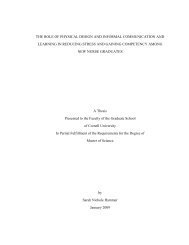The Patient Room: what is the ideal solution? - Cornell University
The Patient Room: what is the ideal solution? - Cornell University
The Patient Room: what is the ideal solution? - Cornell University
You also want an ePaper? Increase the reach of your titles
YUMPU automatically turns print PDFs into web optimized ePapers that Google loves.
<strong>Patient</strong> <strong>Room</strong> and Infection Control<br />
A 2003 study from Simon Fraser <strong>University</strong> looked at <strong>the</strong> use of single patient rooms versus multiple occupancy rooms in acute care<br />
environments across four hospitals in <strong>the</strong> Seattle area and Oregon of varying sizes (bed size of 117, 168, 450, and 697). While <strong>the</strong><br />
percentage of single rooms varied from almost all to drastically less, <strong>the</strong> conclusions were quite similar. Fifty-seven percent of<br />
respondents said that <strong>the</strong> rate of nosocomial infection <strong>is</strong> ei<strong>the</strong>r low or very low in single rooms whereas th<strong>is</strong> number was only 10<br />
percent in double rooms. On <strong>the</strong> o<strong>the</strong>r side, eleven percent said <strong>the</strong> infection rate <strong>is</strong> high or very high in single rooms compared to<br />
forty-six percent in double rooms (Chaudhury, Mahmood, Valente 2003).<br />
We can draw from th<strong>is</strong> some very relevant conclusions. Using a range of different hospitals increases <strong>the</strong> validity of <strong>the</strong> study.<br />
Looking at how <strong>the</strong> data was collected we d<strong>is</strong>cover that survey data was used with 77 respondents total. Of <strong>the</strong>se 77 <strong>the</strong>re were<br />
73 nursing staff members and four admin<strong>is</strong>trative staff members (one from each hospital). What we have <strong>the</strong>n <strong>is</strong> a strong<br />
representation of front-line medical workers who are with patients on a very regular bas<strong>is</strong>. <strong>The</strong>se are <strong>the</strong> people who notice trends,<br />
know <strong>what</strong> <strong>is</strong> normal, know <strong>what</strong> patients want. <strong>The</strong>y recognize which patients develop infections during <strong>the</strong>ir stay and which do not<br />
because it <strong>is</strong> part of <strong>the</strong>ir daily routine to chart all of <strong>the</strong>se things.<br />
14







